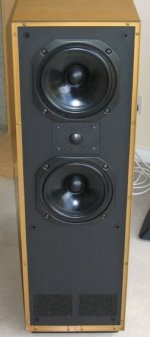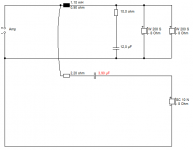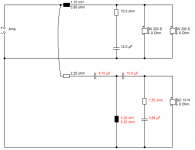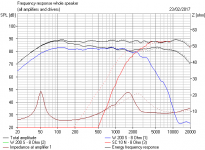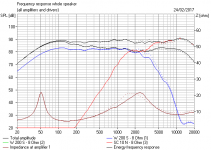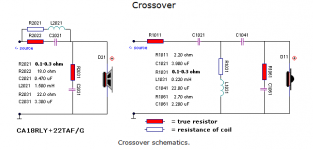Hiya,
I've just replaced all of the components in my TDL Studio 3s crossover.
I've gone for point to point soldering on the components without a pcb or board of any sort.
I've used the following components.
3.9uF 800Vdc Jantzen Superior Z-Cap (ON THE TREBLE)
10R Jantzen Superes 10W Resistor
2R2 Jantzen Superes 10W Resistor (2.2R)
12uF 450V Mundorf Mcap EVO Capacitor (ON THE BASS)
I've also got new inductors of the same value as the originals done by Gerry at Falcon who knows TDL speakers well.
The improvements in the treble is night and day. Much cleaner, more space better soundstage. The bass seems a tiny bit flabbier (not much in it though) but it's the midrange that seems to be worse. Not terrible but noticeably more muffled than before.
I've still got the original Xover in tact but before I start mixing an matching I thought I'd see what you all think could be the reason.
I'm letting them burn in/ run in to see if that makes a difference (I'm not trying to start a chat about that well trodden and controversial issue so let's pretend I never said it...just trying to eliminate all the possibilities!)
The only differences with the original values is the high pass cap which is a 3.9 rather than the original 4. I've also extended the wires a little as they were quite short and needed extra room to work. No more than 6cm with some decent van damme cable I had. I've used solder with a bit of silver in it and they have been running for a day or 2. Oh and the resistors are 10w instead of 5 but I don't believe that should make and difference.
Can anyone suggest why the midrange seems to have got worse?
Thanks
I've just replaced all of the components in my TDL Studio 3s crossover.
I've gone for point to point soldering on the components without a pcb or board of any sort.
I've used the following components.
3.9uF 800Vdc Jantzen Superior Z-Cap (ON THE TREBLE)
10R Jantzen Superes 10W Resistor
2R2 Jantzen Superes 10W Resistor (2.2R)
12uF 450V Mundorf Mcap EVO Capacitor (ON THE BASS)
I've also got new inductors of the same value as the originals done by Gerry at Falcon who knows TDL speakers well.
The improvements in the treble is night and day. Much cleaner, more space better soundstage. The bass seems a tiny bit flabbier (not much in it though) but it's the midrange that seems to be worse. Not terrible but noticeably more muffled than before.
I've still got the original Xover in tact but before I start mixing an matching I thought I'd see what you all think could be the reason.
I'm letting them burn in/ run in to see if that makes a difference (I'm not trying to start a chat about that well trodden and controversial issue so let's pretend I never said it...just trying to eliminate all the possibilities!)
The only differences with the original values is the high pass cap which is a 3.9 rather than the original 4. I've also extended the wires a little as they were quite short and needed extra room to work. No more than 6cm with some decent van damme cable I had. I've used solder with a bit of silver in it and they have been running for a day or 2. Oh and the resistors are 10w instead of 5 but I don't believe that should make and difference.
Can anyone suggest why the midrange seems to have got worse?
Thanks
The reason the treble seems improved is that it's probably just a 1dB or so louder! Because NP electrolytics have an ohm or so of resistance. You'd possibly add an ohm or two at the input to compensate this. 
When you do a rebuild you also tend to expose fresh metal on contacts, which always helps after years of oxidation.
It's not usually recommended to change NP electrolytics on bass shunts to foil types. They have a significant resistance which can help avoid a bass peak and worsened phase alignment at crossover.
Without a schematic, which you are in a better position to draw than me, it's hard to say what is going on.
AFAIK, these are twin 16 ohm polycones of some sort, aka Cobex, possibly wired in parallel. A metal tweeter, which may need fresh ferrofluid, available from Blue Aran in the UK, or Parts Express in the US.
There's lots of things you can do to a speaker like this to improve it, but crossover component upgrades are the least of them. But we all start somewhere...
When you do a rebuild you also tend to expose fresh metal on contacts, which always helps after years of oxidation.
It's not usually recommended to change NP electrolytics on bass shunts to foil types. They have a significant resistance which can help avoid a bass peak and worsened phase alignment at crossover.
Without a schematic, which you are in a better position to draw than me, it's hard to say what is going on.
AFAIK, these are twin 16 ohm polycones of some sort, aka Cobex, possibly wired in parallel. A metal tweeter, which may need fresh ferrofluid, available from Blue Aran in the UK, or Parts Express in the US.
There's lots of things you can do to a speaker like this to improve it, but crossover component upgrades are the least of them. But we all start somewhere...
Attachments
Thanks for the responses. I'll try and add an ohm to the treble and freshen up the ferro fluid.
Just to check as I'm a novice...did you guess already...is it better to add the extra resistor before or after the cap. I'm guessing it shouldn't make a difference as long as it's before it comes out of the speaker.
I'll probably order a few different resistors of different values starting with half an ohm unless you think that would be too Small?
Thanks again
Just to check as I'm a novice...did you guess already...is it better to add the extra resistor before or after the cap. I'm guessing it shouldn't make a difference as long as it's before it comes out of the speaker.
I'll probably order a few different resistors of different values starting with half an ohm unless you think that would be too Small?
Thanks again
Every ohm in front of a 6 ohm (DC) tweeter filter reduces level 1dB. 3dB is a lot, it's half power.
I'd think 3W Maplin wirewounds will do fine. Get 1R and 2.2R, which should be plenty of adjustment. A tweeter is unlikely to ever run at more than 10W.
You could add an ohm or two resistance to the bass capacitor shunt too. I'd probably use 5-10W wirewounds there.
I'd think 3W Maplin wirewounds will do fine. Get 1R and 2.2R, which should be plenty of adjustment. A tweeter is unlikely to ever run at more than 10W.
You could add an ohm or two resistance to the bass capacitor shunt too. I'd probably use 5-10W wirewounds there.
Without seeing a schematic of the crossover, nothing much at all.Thanks all.
System 7 - what other mods would you suggest?
If you are seriously wanting to change stuff here, you need the schematic. You should also measure the DC resistance of the drivers, and the baffle cutout hole sizes. Are these 8" 16 ohm polycones, for instance? I think we decided they have metal tweeters which may need new ferrofluid.
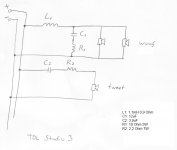 Hiya,
Hiya,Here's the schematic.
The original high pass cap is actually 4 not 3.9. I bought a Janzen 3.9 which sounds very nice but I wonder if the fact it 0.1 uf out will make any difference? (My gut/ears says it is a bit...Janzen don't do a 4 anyway so I have ordered one with a value of 4 from another manufacturer...will report back)
I tried adding a 0.33ohm resistor to the high pass and it sounded very dull and out of whack so I removed it.
I'll sort the wiring out last as I want to tinker a bit with a few different caps first.
Yes they are metal dome tweeters but I don't think there's any need for ferrofluid as the sound is quite sweet and open with the Janzen in. The output sounds the same from both speakers.
It's just the midrange that seems a little off with the Janzen (will the high pass cap make any difference to what goes to the low pass?? ...maybe the new low pass cap has a different R to the original)?
I've ordered a different cap (same value as schematic) for the low pass just to see if that changes anything.
I'm wary of putting a lesser resistor on the low pass because I don't want too risk to much current going to the woofers as I'm not able to replace them if something bad happens...should I be?
I do have a 9.1 ohm that I could try (rather than the prescribed 10 that is in there now).
I have a slightly different model to the one in your picture. I'm guessing it's a later one because it has a flat front rather than the lip for the grill on the older ones. The woofer surround is circular too rather than the squarer ones in other models.
It looks more like this one https://www.hifiengine.com/manual_library/tdl-electronics/studio-3.shtml Although I can't find any photos of similar ones online. Any ideas what the difference is?
So many questions!! Sorry. I'm not very well versed in electronics.
I just love these speakers (They're the 6th and best pair of TDL/IMFs I have owned!)
Any other things I could tinker with...I'm trying to do them one by one so I can learn what's happening as I go!!
Thanks for taking an interest so far.
Christian
Last edited:
The schematic helps a lot! 
I'm guessing these are 16 ohm polycones, but I don't think my rough sim is much affected. I know this territory.
I can't see much point in messing with the bass filter. It's the sort of thing that works well with polycones, which really don't need much work.
The sim shows the single cap tweeter filter in dotted. Also a conversion to third order and zobel. A 7.5R/0.68uF Zobel is just something I like with metal domes, and tames the top end a tidge, and you can try that without changing the rest of the filter.
You could try 4.7uF/0.3mH second order too, without the 10uF. This sort of thing changes the character of a speaker. But definitely lower tweeter distortion, which can be good for complex orchestral music. You keep the 2.2R at the input, because it protects the amplifier from overly low impedance if the tweeter blows.
So there it is. Things to try.
I'm guessing these are 16 ohm polycones, but I don't think my rough sim is much affected. I know this territory.
I can't see much point in messing with the bass filter. It's the sort of thing that works well with polycones, which really don't need much work.
The sim shows the single cap tweeter filter in dotted. Also a conversion to third order and zobel. A 7.5R/0.68uF Zobel is just something I like with metal domes, and tames the top end a tidge, and you can try that without changing the rest of the filter.
You could try 4.7uF/0.3mH second order too, without the 10uF. This sort of thing changes the character of a speaker. But definitely lower tweeter distortion, which can be good for complex orchestral music. You keep the 2.2R at the input, because it protects the amplifier from overly low impedance if the tweeter blows.
So there it is. Things to try.
Attachments
Try returning C1 to it's original.
Usually this cap has a high ESR to begin with. To replace it properly you need to measure the ESR and compensate for it in the series resistor.
This is an unusual case however, as that 10 Ohm resistor in series normally would prevent you from making too big of a mistake. Often this is in the 1-3 Ohm range, and so a change in ESR of a couple of Ohms can make a bid difference.
Best,
E
Usually this cap has a high ESR to begin with. To replace it properly you need to measure the ESR and compensate for it in the series resistor.
This is an unusual case however, as that 10 Ohm resistor in series normally would prevent you from making too big of a mistake. Often this is in the 1-3 Ohm range, and so a change in ESR of a couple of Ohms can make a bid difference.
Best,
E
Looking at the schematic, Erik, I wouldn't expect much difference in the bass shunt performance with ANY capacitor type change. With 10 ohms there already. 
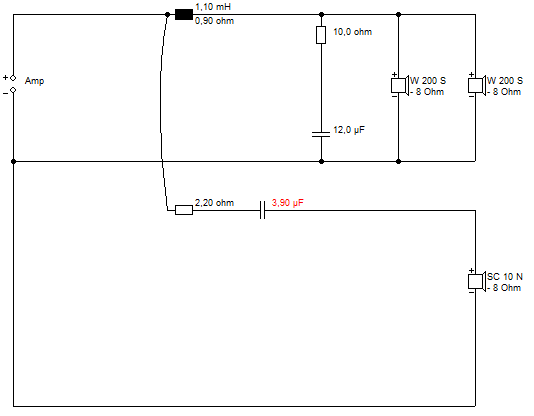
Treble level might jump a dB with a polypropylene replacing a Non Polar.
I used the big ones recently, just because I have them. And they sound good.
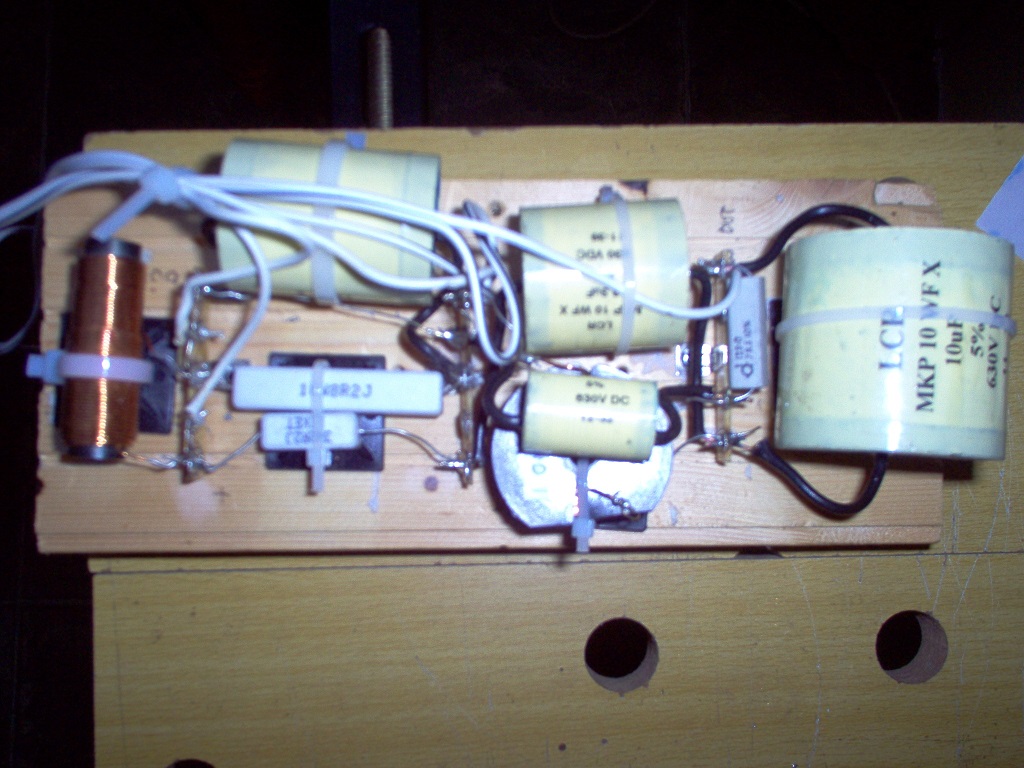
BTW, if you end up with a glut of 12uF, you could easily use them in a 4.7uF/0.3mH/12uF tweeter filter. These values just aren't very critical.

Treble level might jump a dB with a polypropylene replacing a Non Polar.
I used the big ones recently, just because I have them. And they sound good.

BTW, if you end up with a glut of 12uF, you could easily use them in a 4.7uF/0.3mH/12uF tweeter filter. These values just aren't very critical.
Well, I did say it's a very unusual case, but the audible symptoms are kind of similar.
The issue isn't bass, but rather, treble impedance.
Like you point out, with a 10 Ohm resistor in series this would be extremely unusual, but I thought I would mention it just in case.
Best,
E
The issue isn't bass, but rather, treble impedance.
Like you point out, with a 10 Ohm resistor in series this would be extremely unusual, but I thought I would mention it just in case.
Best,
E
Thank you both for getting back so swiftly. Truth be told I only have half or maybe a third of a clue what you have both written but I guess that's how we learn things right!? I can follow the new schematics and have a rough idea of what concepts you are sharing. I'll have another tinker and then report back (probably with more questions)!
Have just put the jenzen 3.9 back on the high pass as the other was too awful to keep in...ever used an iec cap before? Im not a fan... Thanks again for your time.
Have just put the jenzen 3.9 back on the high pass as the other was too awful to keep in...ever used an iec cap before? Im not a fan... Thanks again for your time.
Hi Christian,
It's actually quite easy. It's the resistor in the woofer filter that rules the midrange level. With 10 ohms you get a broad dip of 5 dB at 1.7 kHz and the mids are muffled. With 1 ohm the mids possibly are a bit exaggerated. I assume 2.2 ohms is about right.
Please check your original crossover. I don't believe the resistor really is 10 ohms.
It's actually quite easy. It's the resistor in the woofer filter that rules the midrange level. With 10 ohms you get a broad dip of 5 dB at 1.7 kHz and the mids are muffled. With 1 ohm the mids possibly are a bit exaggerated. I assume 2.2 ohms is about right.
Please check your original crossover. I don't believe the resistor really is 10 ohms.
Hiya. Thanks for your help. I double checked the old resistor and it's definitely 10 ohms /5w. I've changed it with a 10w but as I understand it that shouldn't make a difference if the R is the same.
I'm intrigued to see how the 10ohm affects the presence of the midrange so will try a couple of different values. I have a 9 ohm and then some 3s. I presume I can put a couple together in series and just add their respective values?
Will report back!
Thanks all.
I'm intrigued to see how the 10ohm affects the presence of the midrange so will try a couple of different values. I have a 9 ohm and then some 3s. I presume I can put a couple together in series and just add their respective values?
Will report back!
Thanks all.
The main event on midrange presence is actually the 12uF capacitor.

I just roughly simmed it with a deteriorated bass shunt electrolytic @ say, 4uF. And a 3.9uF electrolytic which we assume has a ESR of 1 ohm. The dotted line.
Once you "upgrade" to polypropylene, you lose a bit of midrange presence with the new 12uF and the tweeter is about 1dB louder. But that may mostly because the original bass shunt capacitor had wandered out of spec, not because it's bad. These are smallish differences.
TBH, I'm winging it a bit on the bass, because I'm using 8 ohm drivers, but the general idea applies. The bass shunt is a very mild but familiar form of impedance correction and added voicecoil damping which I use myself. It doesn't do an awful lot, but tidies everything up around 3kHz, and you can hear the improvement. Troels does something like it here:
CA18RLY/22TAF-G

I just roughly simmed it with a deteriorated bass shunt electrolytic @ say, 4uF. And a 3.9uF electrolytic which we assume has a ESR of 1 ohm. The dotted line.
Once you "upgrade" to polypropylene, you lose a bit of midrange presence with the new 12uF and the tweeter is about 1dB louder. But that may mostly because the original bass shunt capacitor had wandered out of spec, not because it's bad. These are smallish differences.
TBH, I'm winging it a bit on the bass, because I'm using 8 ohm drivers, but the general idea applies. The bass shunt is a very mild but familiar form of impedance correction and added voicecoil damping which I use myself. It doesn't do an awful lot, but tidies everything up around 3kHz, and you can hear the improvement. Troels does something like it here:
CA18RLY/22TAF-G
Attachments
Good morning. I'm picking up this thread from quite a while ago! Hope you are all well.
I have a couple of questions.
I have just replaced the metal dome tdl tweeter with this soft dome.
AUDAX TW025A0 8 ohm 12 x 8 Tweeter, replaces IMF, Celef, Radford
I like the difference so far but I've had to put quite a big resistor after the cap that's feeding it.
Original value for the metal dome was 2.2. The new one is 10 ohm. It feels like it is at the right db now and was very overbearing with lesser values.
Onto my question!
Should I adjust any other xover components now that I have added such a change in resistance (in series)?
And will such a difference to the original value put a strain on the amp/ resistor/ anything else? (I have a fairly powerful amp. 2 rotel rb981s run as monoblocks -360 w per channel)
(System 7...I bought all of the components for the crossover redesign you kindly did. Haven't put them in yet...will I need to change any of their values now I have this new tweeter? I suspect so. Probably should have tried it before the new tweeter went in!! At least I still have the old ones and now have more options to tinker with!!)
Thanks
I have a couple of questions.
I have just replaced the metal dome tdl tweeter with this soft dome.
AUDAX TW025A0 8 ohm 12 x 8 Tweeter, replaces IMF, Celef, Radford
I like the difference so far but I've had to put quite a big resistor after the cap that's feeding it.
Original value for the metal dome was 2.2. The new one is 10 ohm. It feels like it is at the right db now and was very overbearing with lesser values.
Onto my question!
Should I adjust any other xover components now that I have added such a change in resistance (in series)?
And will such a difference to the original value put a strain on the amp/ resistor/ anything else? (I have a fairly powerful amp. 2 rotel rb981s run as monoblocks -360 w per channel)
(System 7...I bought all of the components for the crossover redesign you kindly did. Haven't put them in yet...will I need to change any of their values now I have this new tweeter? I suspect so. Probably should have tried it before the new tweeter went in!! At least I still have the old ones and now have more options to tinker with!!)
Thanks
Last edited:
The main event on midrange presence is actually the 12uF capacitor.

I just roughly simmed it with a deteriorated bass shunt electrolytic @ say, 4uF. And a 3.9uF electrolytic which we assume has a ESR of 1 ohm. The dotted line.
Once you "upgrade" to polypropylene, you lose a bit of midrange presence with the new 12uF and the tweeter is about 1dB louder. But that may mostly because the original bass shunt capacitor had wandered out of spec, not because it's bad. These are smallish differences.
TBH, I'm winging it a bit on the bass, because I'm using 8 ohm drivers, but the general idea applies. The bass shunt is a very mild but familiar form of impedance correction and added voicecoil damping which I use myself. It doesn't do an awful lot, but tidies everything up around 3kHz, and you can hear the improvement. Troels does something like it here:
CA18RLY/22TAF-G
- Home
- Loudspeakers
- Multi-Way
- TDL Studio 3 crossover upgrade is better and yet worse as well
